Sun 29 Apr 2012
The more I weave, the more I realize that I want to sew with my handwoven fabrics. I also want to spin for handweaving, which is why I’ve been working so hard to spin finer and finer yarns (I don’t need that much laceweight!). I’ve wanted to do both of these things for quite some time, but so far, I’ve done neither.
On Friday, I decided to fix that. I took the long repeat version of the Shetland sample skeins that I spun for the show, and wound it onto my warping board (this is how you make 100 2-yard pieces of exactly the same length).
Then, I put it on the loom and started warping; threading all of those ends through the loom one at a time in the right pattern for weaving.
Once the loom was warped, I tied the ends onto the front beam of the loom and marveled at the color gradient.
(Sorry for the slightly blurry pic.)
When I had done the original calculations, I thought I’d get a piece that was 8-10″ wide, but when I started putting in on the warping board I realized that I needed to make the warp longer, and so ended up with a 4-5″ strip. I almost stopped when I realized that I wouldn’t get the full width, but then I decided to just go with it and see what happened. So I did.
I wove the fabric using the short color repeat yarn (about 2 yards per color), and you can see here how the two gradients interact. In the bottom left, both the warp and the weft are blue. In the top right, they’re both yellow.
An hour or two later, I had this:
If you look closely at the color repeats, you can see an interesting effect of the way I spun the yarn. Remember that I split the top into thin strips before spinning? They began on a yellow, and ended on a blue. All of the colors in between were spun continuously, but at the end of every blue segment I would stop and add on a new strip, starting with blue. That meant that there was no mixing between the yellow and blue while I spun, and so there’s a hard transition between those two colors, and a gradual transition everywhere else.
That wasn’t something I thought much about when I was spinning the skein, but it had a really interesting effect in the final piece. Instead of being one long, smooth gradient, the fabric has short gradient sections punctuated by an abrupt change in color.
The final piece ended up being about 4″ wide and 50 inches long. So, what do you do with a thin strip of fabric?
At first, I thought I might just keep it for petting and looking at. But I really want to sew with my handwoven, and so I kept thinking. Most traditional African textiles are woven in strips of about this size, so clearly there are ways to use a narrow strip like this.
I cut a thin strip of paper, and started playing around. It wasn’t very long before I had this:
That’s one strip of paper folded at 45 degree angles to make a solid tube. Kind of like a bag, in fact.
I wanted a somewhat wider strip of fabric for the bag, so I sewed the strip lengthwise to make it twice as wide. I used a butt selvedge seam, which is something I’d never do on a commercial fabric, because the selvedge on a commercial piece is usually very different than the main material. In handwoven, there’s really no difference, so you can sew the two pieces right along the edge without folding anything over. It’s also especially handy in a handwoven, because the fabric tends to be thicker and might distort around a fold.
When I got to the raw end of the fabric, I folded it over and used a (very messy) whipstitch to tack it in place, just to keep those ends contained.
Then, the fun began. Starting at the tacked end, I folded the fabric into a triangle to make a corner of the bag, and sewed the edges of the strip together.
Then I turned it over, and folded it again.
And sewed another seam.
Then, I trimmed the extra points at the top of the bag, and got two triangles that I could use to fill in the holes.
In all, I had only a tiny bit of fabric left over.
And a little more yarn left over, which may need to find its way into another project sometime.
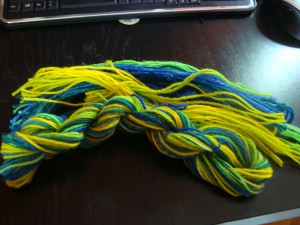
Then, I made a lining, with a pocket for the inside.
After sewing in the lining and adding a strap made from the same fabric, I had a bag.
I even put the little reinforced-diamond thingys on the handle, to make sure it’s extra secure (and mostly because I like the way they look).
And now, I have a new bag, sewn from my handwoven handspun handdyed yarn. Isn’t that fun?
I am especially pleased with how the colors came out. I did absolutely no planning about the color placement, but I really like how they work together. It’s amazing what a difference it made to sew with the bias angle (45 degrees). I had laid the fabric out in rectangular strips for a simpler design, and didn’t like the colors at all. The bias gives it a very dynamic, almost plaid look that I like a lot. Now, I just need to find an occasion to use it.
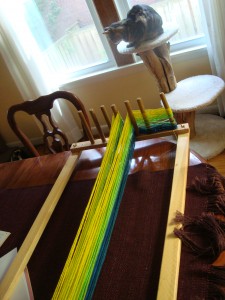
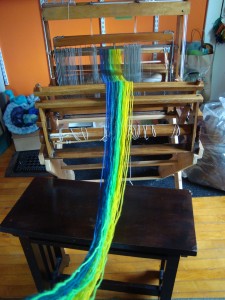
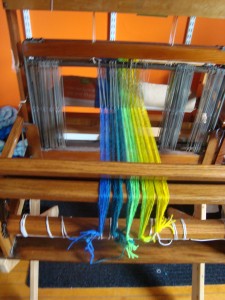
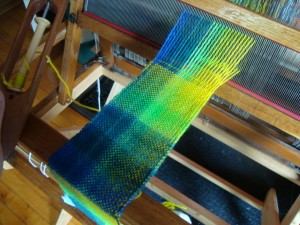
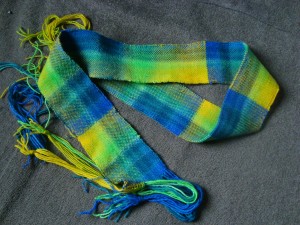
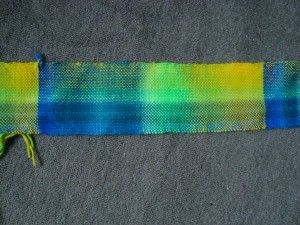
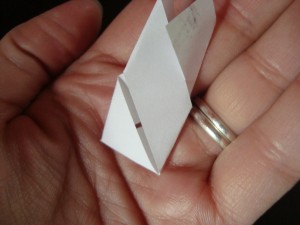
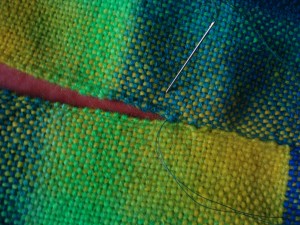
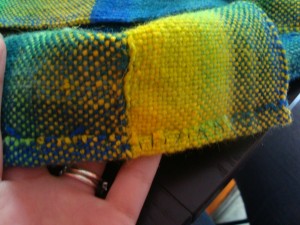
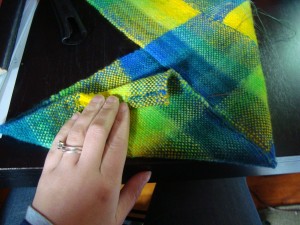
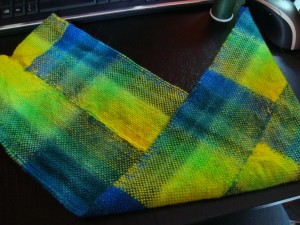
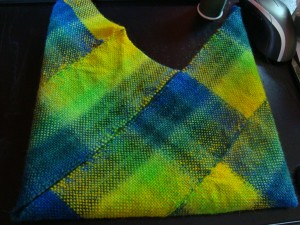
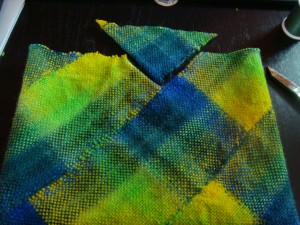
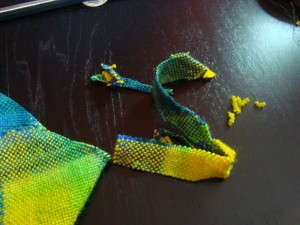
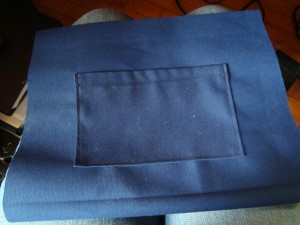
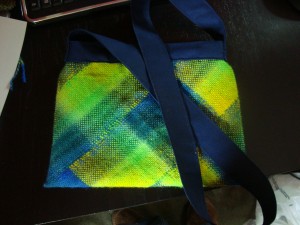
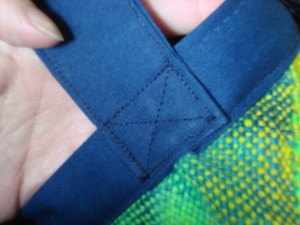
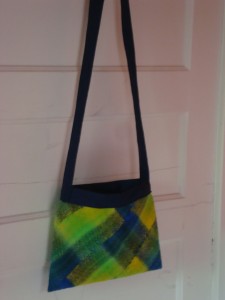
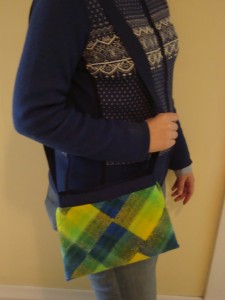
That is so nifty! Love how it turned out!
I love your bag! The colors on the diagonal make it much more interesting to look at.
that’s beautiful!
This is really pretty. Just thinking about the small piece of fabric and manipulating it turned it into a beautiful, useful object. The colors are great too.
Oh how neat! I really love the way the weaving turned out with the two different lengths of color repeats and then when folded into the bag it works really well.
The color results are fantabulous. I really like this fabric!
I love it! Yet another example of the way that what might seem like an impossible constraint (narrow width due to using a particular-sized loom) actually leads to something really wonderful.
Wow, I am so impressed!!
You keep this up and you might lure me into weaving. I’m going to take the scarf I’m knitting and try folding it into a bag too — not permanently (the scarf is a gift), just to see how the diagonal slip stitch pattern works out…might be inspiration for another project! I’ll put pictures on our blog when I get to it.
Oh, that is SO cool!
Beauty! FINALLY found it. I made a woven scarf that didn’t come out great, and wanted to turn it into a bag. Took SO long to find a suitable tutorial! Thank you!!